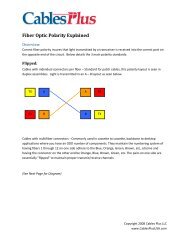Learning About Options in Fiber - Cables Plus USA
Learning About Options in Fiber - Cables Plus USA
Learning About Options in Fiber - Cables Plus USA
Create successful ePaper yourself
Turn your PDF publications into a flip-book with our unique Google optimized e-Paper software.
SECTION 2—FIBER-OPTIC BASICS<br />
SPECTRAL WIDTH<br />
Earlier, we discussed material dispersion and the<br />
fact that different wavelengths travel through a<br />
fiber at different velocities. The dispersion<br />
result<strong>in</strong>g from different velocities of different wavelengths<br />
limits bandwidth.<br />
Figure 2-16—PN Photodiode<br />
n<br />
p<br />
Lasers and LEDs do not emit a s<strong>in</strong>gle wavelength;<br />
they emit a range of wavelengths. This range is<br />
known as the spectral width of the source. It is<br />
measured at 50 percent of the maximum amplitude<br />
of the peak wavelength.<br />
DETECTORS<br />
The detector <strong>in</strong> the fiber-optic system converts the<br />
optical signal <strong>in</strong>to an electrical signal compatible<br />
with conventional equipment and communications<br />
networks.<br />
A good signal detector responds well to light at<br />
the peak <strong>in</strong>tensity wavelength of the light source<br />
and fiber comb<strong>in</strong>ation used (800-900 nanometers,<br />
1,000-2,000 nanometers). It also operates with low<br />
<strong>in</strong>terference, has high reliability, long operat<strong>in</strong>g<br />
life, and small size.<br />
PHOTODIODE BASICS<br />
In mov<strong>in</strong>g from the conduction band to the valence<br />
band (the energy bands <strong>in</strong> semiconductor material),<br />
by recomb<strong>in</strong><strong>in</strong>g electron-hole pairs, an electron<br />
gives up energy. In a LED, this energy is an<br />
emitted photon of light with a wavelength determ<strong>in</strong>ed<br />
by the band gap separat<strong>in</strong>g the two bands.<br />
Emission occurs when current from the external<br />
circuit passes through the LED. With a photodiode,<br />
the opposite phenomenon occurs: light fall<strong>in</strong>g on<br />
the diode creates current <strong>in</strong> the external circuit.<br />
Absorbed photons excite electrons from the<br />
valence band to the conduction band, a process<br />
known as <strong>in</strong>tr<strong>in</strong>sic absorption. The result is the creation<br />
of an electron-hole pair. These carriers, under<br />
the <strong>in</strong>fluence of the bias voltage applied to the<br />
diode, drift through the material and <strong>in</strong>duce a<br />
current <strong>in</strong> the external circuit. For each electron-hole<br />
pair thus created, an electron is set flow<strong>in</strong>g as<br />
current <strong>in</strong> the external circuit. Several types of semiconductor<br />
detectors can be used <strong>in</strong> fiber-optic<br />
systems — the pn photodiode, the p<strong>in</strong> photodiode,<br />
and the avalanche photodiode.<br />
The pn Photodiode<br />
The simplest device is the pn photodiode. (Refer<br />
to Figure 2-16.) Two characteristics of this diode,<br />
however, make it unsuitable for most fiber-optic<br />
applications.<br />
First, because the depletion area is a relatively<br />
small portion of the diode’s total volume, many of<br />
the absorbed photons do not result <strong>in</strong> external<br />
current. The created hole and free electrons<br />
recomb<strong>in</strong>e before they cause external current. The<br />
received power must be fairly high to generate<br />
appreciable current.<br />
Second, the slow tail response from slow diffusion<br />
makes the diode too slow for medium- and highspeed<br />
applications. This slow response limits<br />
operations to the kilohertz range.<br />
Figure 2-17—PIN Photodiode<br />
The p<strong>in</strong> Photodiode<br />
The p<strong>in</strong> photodiode is designed to overcome the<br />
deficiencies of its pn counterpart. While the p<strong>in</strong><br />
diode works like the pn diode, it has its peak sensitivity<br />
to light signals at 1,000-2,000 nanometers<br />
<strong>in</strong> wavelength and can be used with LED sources<br />
and medium- to high-loss fiber.<br />
The name of the p<strong>in</strong> diode comes from the layer<strong>in</strong>g<br />
of its materials: positive, <strong>in</strong>tr<strong>in</strong>sic, negative—p<strong>in</strong>.<br />
(Refer to Figure 2-17.) Care must be exercised <strong>in</strong><br />
p+<br />
i<br />
n<br />
2-13
















